
La Crosse's Radiant History
(written by Sarah Ludington, Archives staff)
Within the last decade, many people have become familiar with the story of the Radium Girls. While directing the play “Our Shining Girls,” Kate Moore was inspired to research and write the non-fiction best-seller The Radium Girls: The Dark Story of America's Shining Women in 2017 which went on to be a popular book club pick and later, a movie. It detailed the nearly forgotten story of the young women who worked for three of the biggest radium processing plants in the U.S. at the start of the “luminizing industry” in the early twentieth century and how they fought for compensation when the practices they were trained to do lead to the deaths of many of them. The story of radium in the U. S., however is not confined to the three companies discussed in the book. Many other cities had industries and businesses that required working with the highly radioactive element. La Crosse was one of these cities and this is the story of one of the lesser-known companies that operated here during this time.

A pamphlet for the Panama-Pacific Exposition featuring the Court of Palms. Image is in the public domain and was accessed through Wikimedia Commons
It was spring in 1915 and Lewis K. Fullerton, a foreman at the La Crosse Gas & Electric Co., had just returned home to La Crosse from a trip west which included visiting the Panama-Pacific International Exposition in San Francisco. A world’s fair in honor of the completion of the Panama Canal and the return of the city from the destruction caused by the 1906 earthquake, the exposition was said to be so large, one could spend 24 hours there and still not see all it had to offer. Halls were temporarily constructed to house exhibitions on subjects like machinery, horticulture, fine arts, etc. Among them was the Liberal Arts Palace. The building surrounded the Court of the Four Seasons and there inside the was an exhibitor promoting the wonders of radium. It’s not known for certain that Lewis would have walked by or even stopped to take in this display of plants growing in radioactive soil, but even if he didn’t it was hard to miss the fervor surrounding the relatively new element.
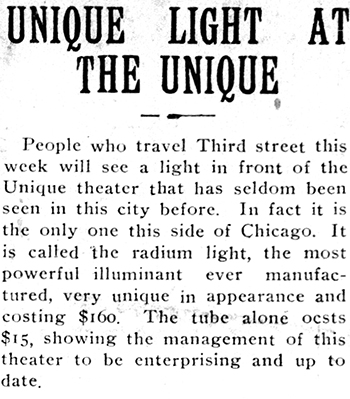 This item from the Sept. 25, 1906 issue of the La Crosse Tribune illustrates the novelty and curiosity surrounding radium at the time
This item from the Sept. 25, 1906 issue of the La Crosse Tribune illustrates the novelty and curiosity surrounding radium at the time
Radium was famously discovered by the Curies, Marie and Pierre, in 1898. It was found in the waste byproduct of uranium mining: a substance called pitchblende. By the time of Lewis’ trip, research (which, it would turn out, was not objective) was supporting the use of the element in medicine, especially in the treatment of cancer. It would seem that once this bar was set, radium began to be used in all sorts of things: spa treatments, tonics, and fabrics; some of them legitimately contained radium, most did not. It was a wonder of science and a terrific marketing opportunity!


Ads in the La Crosse Tribune from 1922 and 1932, respectively, for fabric supposedly made with radium
In La Crosse, radium was being used in a few different ways. It had been purchased by at least two hospitals for use in cancer treatment. A La Crosse Tribune article from 1922 mentions the Lutheran hospital planning to spend at least $10,000 that year on a total of 100 milligrams of it. St. Francis Hospital also had radium in its possession. Other businesses took advantage of the glow found to be given off by the element. In 1927, Northern Engraving, which had been in business since 1919, found that producing dials for automobiles was lucrative enough for the company to expand. Those dials were treated with a glowing radium paint to make them visible at night. Another company, National Gauge & Equipment (later Electric Auto-Lite), also used radium in the manufacture of its dials.
By 1930, Lewis had worked for both of those companies and his experience coupled with a drop in the cost of radium (due to alternative methods of extracting radium from domestic ore) likely paved the way to him opening up his own business. In May 1931, the Tribune reported that Mr. L. K. Fullerton would be the manager of a new factory that would manufacture “watch dials and airplane instruments.” It would be called Central Dial & Radium.
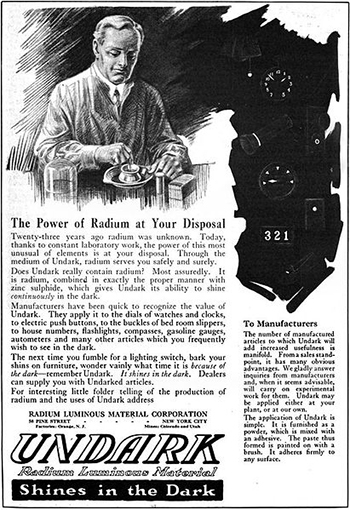
A 1921 magazine ad for Undark, the radium paint developed by the Radium Luminous Material Corporation. Image is in the public domain and was accessed through Wikimedia Commons
At the time, applying the paint to the small figures printed on watch and instrument dials was viewed as work more suited for the “delicate” hands of women. Lip-pointing, or bringing the brush to a point by mouth after dipping in the paint, was initially taught to the women as the most efficient and precise way to apply it. In the early days of the industry, the paint, Undark, was mixed with an isotope of radium called Ra-226. This isotope’s half-life, the time it would take to break down and stop emitting its harmful rays, is 1,600 years. A few years later, the isotope was changed to one called mesothorium which had a shorter half-life (about 6 years) and was cheaper to produce. According to Shirley A. Fry’s 1998 paper, “Studies of U.S. Radium Dial Worker: An Epidemiological Classic,” it was found that workers who began working in the “luminizing industry” after 1929 “were found to have little or no radium burden” in their bodies. It was the workers, sometimes given romantic titles such as “painters” or “artists,” that used the earlier form of the radium paint who suffered the most severely as a result of their exposure to it.

Dial painters at work in 1922 at the United States Radium Corporation in New Jersey. Image is in the public domain and was accessed through Wikimedia Commons
It was around this time, in 1930, that Irene Schedivy graduated from La Crosse High School. It appears from city directory information that Irene’s very first job was as a stenographer for Central Dial & Radium. Granted, it doesn’t seem that Irene would have been working directly with any radium or radium paint as a stenographer, but the quarters were close in the offices of Central Dial. In fact, the business only employed about 5 to 6 employees at any given time, two of them being Lewis and his wife, Rena.
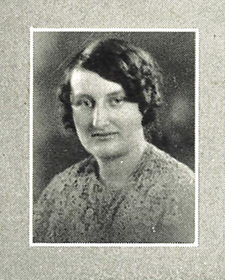
Irene Schedivy (sometimes spelled Sedivy) as a high school senior, from La Crosse High School’s 1930 yearbook
In 1938, it looked as though Mr. Fullerton was hoping to expand his business. An item in the Tribune mentions that he was traveling to Chicago to start a branch there. However, about a year and a half later, it was reported that instead of a new branch opening there, a man from Chicago would be buying the company from Lewis.

May 5, 1940 La Crosse Tribune article regarding the sale of Central Dial & Radium
According to the Tribune, the new owner was Chester Barton Rich, or C. B. Rich. He also had experience with watch dials. It reported that he had worked for the “Lirk-Rich Dial Corporation”. (This may be a typographical error; the Kirk-Rich Dial company specializing in watches continues to this day, though no longer in Chicago.) Mr. Rich would eventually move Central Dial & Radium to a larger location in La Crosse and change its name to the C. B. Rich Company. After the U.S. entered World War II in 1941, that larger space would be put to good use.

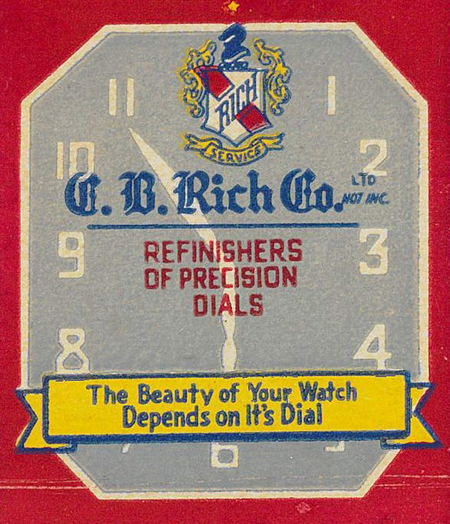
Promotional materials for the C. B. Rich Co.: a jeweler’s gauge and matchbook. Ruler image from eBay seller PGASteelers1
According to city directory data, that year the C. B. Rich Co. employed five people, Irene Schedivy included. C. B. Rich would never live in La Crosse and always employed a manager to run the business for him. In 1943, the number of employees jumped to 51, many of them women, and almost all of them listed as “painters.” Over the next ten years, into the 1950s, the company would continue to operate, moving locations once more. However, after the war the number of employees began to diminish. By 1953, according to city directory data, only 15 people were employed there and only a handful of them had been there long-term. The company seemed to quietly cease operations around 1955 or 1956, as it was no longer listed in the city directory.
Briefly after the sale of his business, Lewis Fullerton worked at Northern Engraving again. In 1945, though, articles of organization were filed for a new company called Gateway Glass. Lewis served as vice-president of this company for over 10 years. The company would merge with Northern Engraving in 1964 and change its name to Gateway Products Corporation. They specialized in instrument dials and also used radium. Lewis retired by about 1960 and passed away at the age of 79 in 1967.
Irene would stay with the company the entire time it operated. With the name changes and all of the moves she was always listed as the stenographer. When it closed, she also moved on to Gateway Products, as did many of the other original Central Dial & Radium employees, where they possibly continued to work with radium.
By this time, there had been many changes in the standards for working with materials like radium since the early twentieth century. Lip-pointing stopped being used by 1930, amidst the lawsuits brought about by the dial painters at the time. The experiences of these women and the ramifications of their lawsuits were contributing factors in the later creation of the Occupational Safety and Health Administration (OSHA) in 1971.
Irene left the luminizing industry after over twenty years, sometime between 1957 and 1958, when she married widower Palmer Hanson and helped raise his children. Irene died in 2009 at the age of 97. In fact, most of the long-term employees of the company lived long lives. Three other painters who worked for the company during the C. B. Rich years, Phyllis Bottcher Burcum, Mabel Ferris Sagear, and Evelyn Dikeman Eno lived well into their 80s.
Perhaps because of timing and safety precautions, La Crosse’s history in the luminizing industry does not seem to have been as devastating to its workers as it was for those women whose story was told by Moore in The Radium Girls, but their experiences are not well-documented either. If you have any further information about Central Dial & Radium or the C. B. Rich Company, or La Crosse’s luminizing industry, please contact the Archives & Local History Department at archives@lacrosselibrary.org or (608) 789–7136.
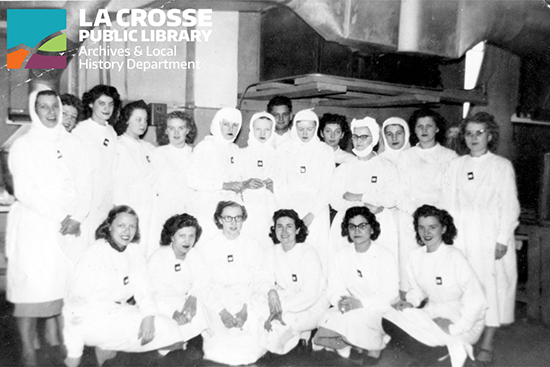
A photo from the late 1940s-early 1950s of Gateway Glass Co. workers, some of La Crosse’s own “Radium Girls.” Photo courtesy of former Gateway Glass employee Doris Burns
